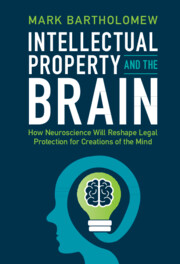 Intellectual Property and the Brain
Intellectual Property and the Brain from Part III - Using Neuroscience to Improve Intellectual Property Law
Published online by Cambridge University Press: 14 July 2022
Copyright’s test for infringement takes a uniform approach to aesthetics by treating all audiences and modalities of creative expression the same. We now know that this is not how aesthetic judgment works. The chapter describes how the law can be reformed to take differences in audiences and artistic media into account. The chapter also responds to potential objections to the use of neuroaesthetics in this legal context. A better understanding of how audiences perceive art, if implemented in the right manner, can help protect both economic and non-economic values embedded in copyright law in a more transparent way.
To save this book to your Kindle, first ensure [email protected] is added to your Approved Personal Document E-mail List under your Personal Document Settings on the Manage Your Content and Devices page of your Amazon account. Then enter the ‘name’ part of your Kindle email address below. Find out more about saving to your Kindle.
Note you can select to save to either the @free.kindle.com or @kindle.com variations. ‘@free.kindle.com’ emails are free but can only be saved to your device when it is connected to wi-fi. ‘@kindle.com’ emails can be delivered even when you are not connected to wi-fi, but note that service fees apply.
Find out more about the Kindle Personal Document Service.
To save content items to your account, please confirm that you agree to abide by our usage policies. If this is the first time you use this feature, you will be asked to authorise Cambridge Core to connect with your account. Find out more about saving content to Dropbox.
To save content items to your account, please confirm that you agree to abide by our usage policies. If this is the first time you use this feature, you will be asked to authorise Cambridge Core to connect with your account. Find out more about saving content to Google Drive.